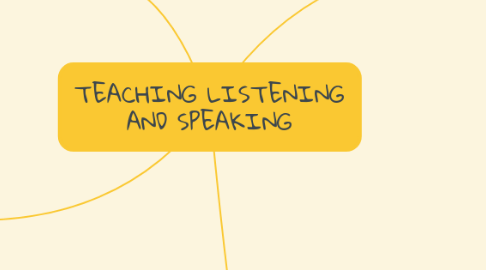
1. Considerations for Teaching Listening and Speaking
1.1. It's important to consider children’s interests and real lives
1.2. The teacher should includes real-life listenings
1.3. It is important to teach students to communicate orally in real conversations
2. Considerations for Teaching Listening
2.1. What Is Listening?
2.1.1. It's an active process.
2.1.2. Interpret the message accurately in order to make sense
2.2. 3 stages of listening comprehension
2.2.1. 1. Perceptual processing,
2.2.1.1. The sound encoded is perceived and recognized as language
2.2.2. 2. Parsing
2.2.2.1. The language is decoded and stored in short-term memory
2.2.3. 3. Utilization
2.2.3.1. The listener matches the language heard with ideas stored in long-term memory.
2.3. Bottom-Up and Top-Down Listening
2.3.1. Bottom-up processing
2.3.1.1. To interpret the sounds from the unit to the context, it means decoding parts of the language.
2.3.1.1.1. Activities
2.3.2. Top-down processing
2.3.2.1. Refers to interpret the message through the context (from the context to the unit)
2.3.2.1.1. Activities
2.4. Principles for Teaching Listening to YLs
2.4.1. Prepare teacher talk carefully
2.4.1.1. It's better to use short segments or comprenhensible listening input when giving instructions
2.4.2. Use listening activities that reflect real-life listening
2.4.2.1. Involve authentic language and real-world contexts as much as possible.
2.4.3. Use listening activities that are developmentally appropriate
2.4.3.1. Activities should take into consideration learners’ age, background knowledge, and interests.
2.4.4. Use a variety of techniques to make listening input comprehensible
2.4.4.1. Prepare students for the context (Use realia and hands-on activities for better comprehension)
2.4.5. Check comprehension using a variety of response types
2.4.5.1. Teachers can check comprehension using a variety of response types that should be both verbal and nonverbal.
2.4.6. Keep listening active—always give learners a listening task
2.4.6.1. Every listening activity should give YLs a purpose for listening and, better yet, a task to complete.
2.4.7. Equip your students with intelligent guesswork strategies
3. Considerations for Teaching Speaking
3.1. What is speaking?
3.1.1. Represents the main mode of communication.
3.1.2. It hekps to interact with others
3.2. Fluency vs. Accuracy
3.2.1. Fluency
3.2.1.1. It refers to the spped and natural flow of the language
3.2.1.1.1. Repetition is important through songs, chants and rhymes
3.2.2. Accuracy
3.2.2.1. It refers to the use of grammar while speaking
3.2.2.1.1. It's better to teach throoug chunks and repetition
3.3. Principles for teaching speaking to YLs
3.3.1. Build classroom routines in English.
3.3.1.1. It will ensure that every day students can use the language
3.3.2. Use speaking activities that reflect real-life communication.
3.3.2.1. Like songschants, rap, storytelling cartoons and movies.
3.3.3. Use speaking activities that are developmentally appropriate.
3.3.3.1. Activities, should take into consideration learners’ age, background knowledge, and interests.
3.3.4. Use a variety of activities to improve both accuracy and fluency.
3.3.4.1. Controlled practice
3.3.4.2. Guided practice
3.3.4.3. Independent practice
3.3.5. Build classroom interaction by giving students plenty of opportunities to participate.
3.3.5.1. Sudents need a chance to speak out and practice during every class.
3.3.6. Keep the speaking environment active—do not correct errors explicitly.
3.3.6.1. YLs need a comfortable classroom atmosphere so they can speak out and work with the languge
3.3.7. Equip your YLs with negotiation strategies.
3.3.7.1. Students need some chunks to help them clarify meaning
4. Effective Listening and Speaking Activities
4.1. Conceptualize activities in 3 stages
4.1.1. Before listening/ Warm-Up Stage
4.1.1.1. Prepare Ss for the listening input
4.1.2. During listening/ Presentation Stage
4.1.2.1. "Listening and..." activities
4.1.3. After listening/ Practice and application Stage
4.1.3.1. Speaking activities
